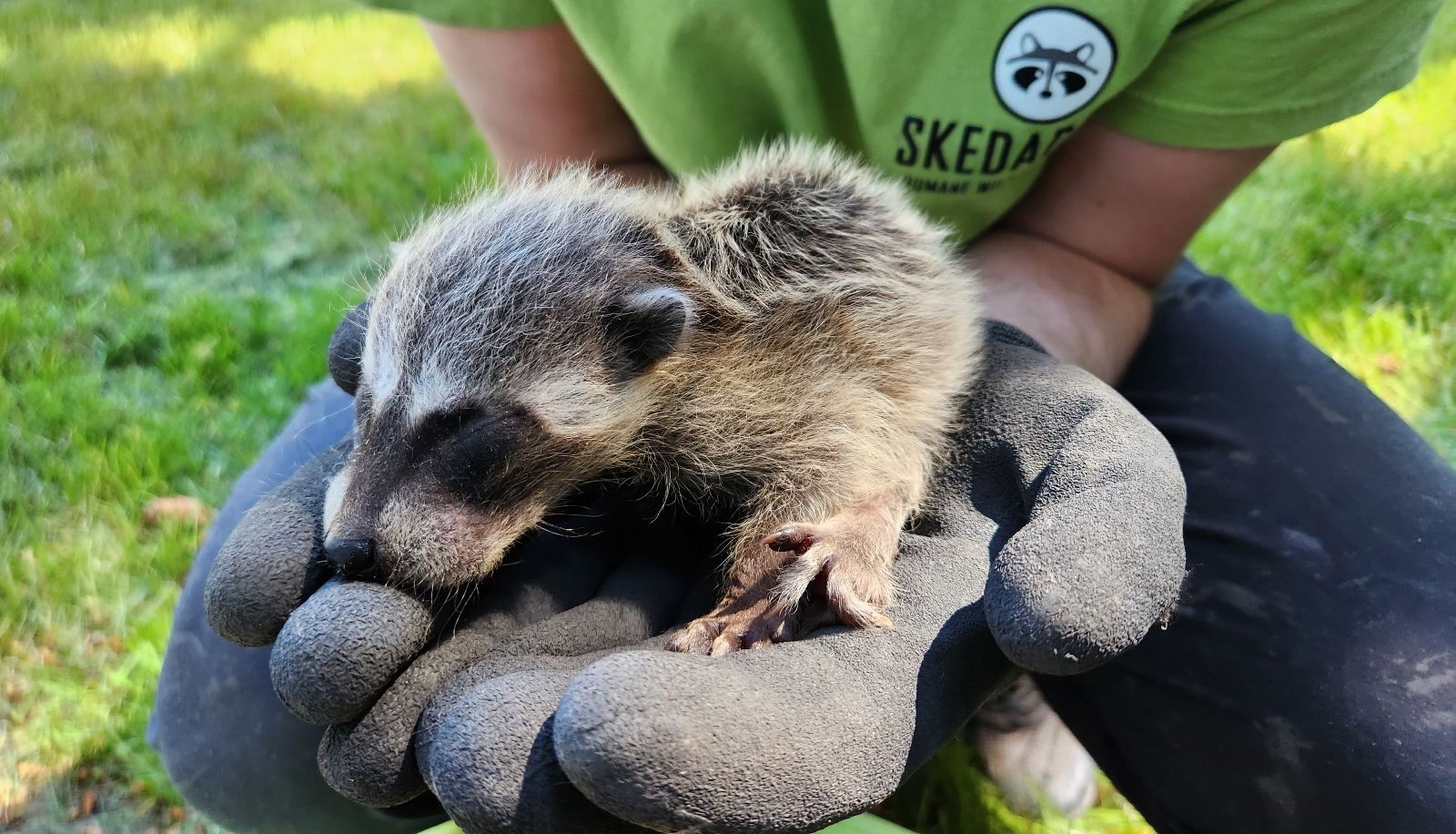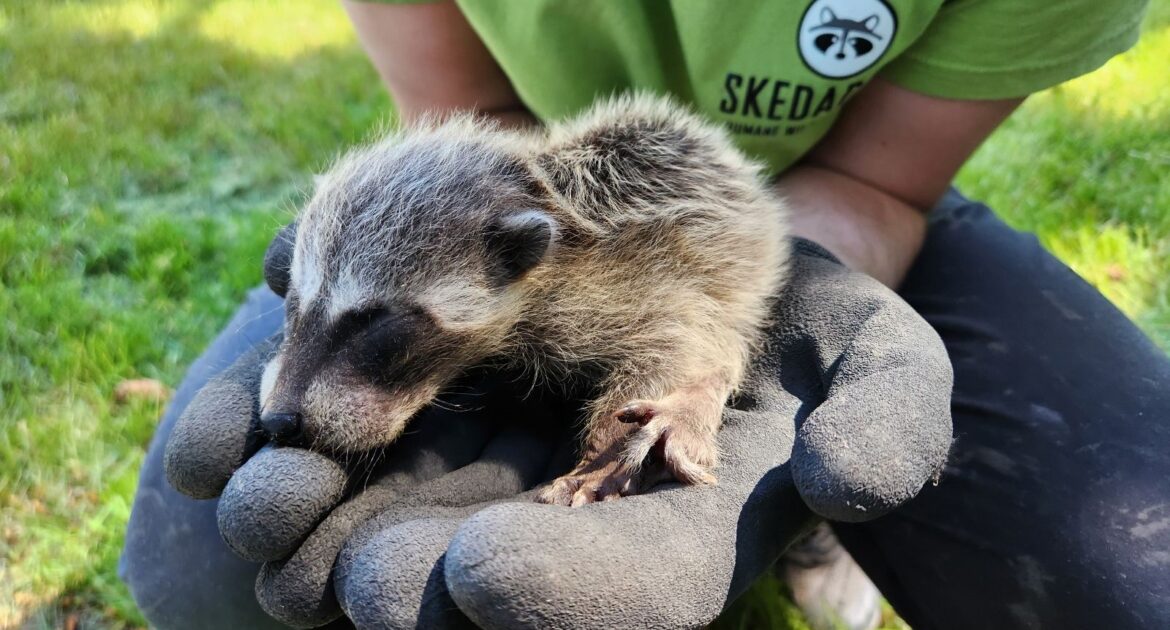In the heart of Whitechurch-Stouffville, where urban neighborhoods blend seamlessly with natural landscapes, residents often witness the fascinating world of raccoon family behavior unfold in their backyards, parks, and sometimes even their attics. These masked wildlife neighbors, with their distinctive ringed tails and dexterous paws, lead complex social lives that go far beyond their reputation as midnight garbage raiders. Understanding raccoon family dynamics provides not only fascinating insights into these intelligent creatures but also helps homeowners better protect their properties from potential unwanted intrusions.
At Skedaddle Humane Wildlife Control, we’ve spent over three decades observing and humanely managing raccoon behavior throughout York Region. What many residents don’t realize is that these creatures, often viewed as solitary troublemakers, maintain intricate family structures and sophisticated parenting systems that rival those of many mammals. Let’s explore the hidden world of raccoon families and discover how these clever animals raise and teach their young.
The Unique Structure of Raccoon Families
When wandering the trails near the Whitechurch-Stouffville Museum & Community Centre, you might spot a raccoon family navigating the landscape together. But what exactly constitutes a raccoon family unit?
Unlike many mammals that maintain year-round family groups, these wildlife social structures are more fluid and adaptable. While commonly perceived as solitary animals, raccoons actually engage in complex temporary social behaviors, particularly during mating season and while raising young.
- Mother-centered families: The primary family unit consists of a mother and her cubs (called kits). Male raccoons typically don’t participate in raising young.
- Seasonal variations: During winter months in York Region, raccoons may temporarily den together for warmth, forming small groups that aren’t necessarily related.
- Extended family connections: Young female raccoons sometimes establish territories near their mothers, creating loose extended family networks across neighborhoods.
The size and composition of a typical raccoon family consist of a mother and 2-6 kits, although larger litters are possible. The number of young often depends on the mother’s age, health, and the food availability in the area.
Understanding these family structures is critical for homeowners in Whitechurch-Stouffville who may encounter raccoon families seeking shelter in attics or under decks, especially during the breeding season.
Raccoon Mating and Birth Cycles in York Region
The family journey begins with the mating season, which in York Region typically occurs from late winter (January through March). This period presents unique challenges for local property owners as male raccoons become more active and vocal while searching for mates.
The Raccoon Reproduction Timeline:
- Mating season (January-March): Male raccoons travel extensively to find females, sometimes fighting with other males for mating rights.
- Gestation period (approximately 63 days): Female raccoons prepare nursery dens during this time, often selecting attics, chimneys, or other protected spaces in human structures.
- Birth season (late March through June): Most kits in Whitechurch-Stouffville are born during this period, with mothers seeking secure, warm locations for their vulnerable offspring.
- Nursing period (8-12 weeks): During this time, mother raccoons are highly protective and will defend their young aggressively if threatened.
The arrival of spring in York Region coincides with the birth of raccoon kits, making this a critical time for homeowners to be aware of potential den sites on their property. A pregnant raccoon specifically seeks out locations that offer protection, warmth, and proximity to food and water sources—qualities that human homes often provide in abundance.
How Mother Raccoons Care for Their Young
The cornerstone of raccoon family behavior revolves around the dedicated care provided by mother raccoons. From birth until independence, they demonstrate remarkable parenting skills that ensure the survival of their young even in challenging urban environments like Whitechurch-Stouffville.
When raccoon kits are first born, they are completely helpless—blind, deaf, and weighing only about 75 grams (smaller than a tennis ball). Their distinctive mask markings are already visible by 10 days of age, but they remain entirely dependent on their mother for survival.
For the first few weeks, the mother rarely leaves her kits, nursing them frequently and keeping them warm. When she must forage for food, she returns quickly, demonstrating strong maternal instincts.
- Den management: Mother raccoons maintain clean denning areas by designating specific latrine areas away from the nest. They may also relocate their entire family if they sense danger or if the den becomes too soiled.
- Protection from threats: Mother raccoons are notoriously protective of their young and will confront much larger animals—including humans and pets—if they perceive a threat to their kits. This protective behavior is especially important for residents who might encounter raccoon families on their property.
- Feeding transitions: As kits grow, the mother gradually introduces solid foods, often bringing items back to the den for young raccoons to examine and taste. This process begins when kits are about 6-9 weeks old and represents an important step in their development.
How Raccoons Raise Young Pups
One of the most fascinating aspects of raccoon parenting is the extensive “education” that mothers provide their young. These teaching sessions prepare young raccoons for independent life and showcase the remarkable intelligence of these mammals.
How Mother Raccoons Teach Survival Skills:
Mother raccoons conduct what amounts to a comprehensive wilderness survival course for their offspring, with lessons that typically include:
- Foraging techniques: Mothers demonstrate how to find food sources, overturn rocks and logs, and search efficiently for meals. In Whitechurch-Stouffville neighborhoods, this might include showing kits how to access gardens, fruit trees, or unsecured garbage cans.
- Water navigation: Young raccoons learn to wash food and hunt for aquatic prey like crayfish, frogs, and small fish in local streams and ponds.
- Climbing skills: Mothers teach proper climbing techniques, essential for escaping predators and accessing elevated food sources and den sites.
- Predator avoidance: Young raccoons learn to recognize potential threats, including domestic dogs, coyotes, and humans.
Around 8-12 weeks of age, mother raccoons begin taking their kits on short excursions away from the den. These outings start after dusk and gradually increase in duration and distance as the young raccoons develop confidence and skills.
Adapting to Urban Life in Whitechurch-Stouffville
Raccoon families in York Region have become masters at adapting to human environments, with mothers specifically teaching young raccoons how to navigate the unique challenges and opportunities of urban and suburban settings.
These young raccoons benefit from their mother’s guidance in identifying reliable food sources unique to human environments—gardens, compost bins, pet food left outdoors, and fruit trees are all included in these lessons.
- Human avoidance behaviors: Young raccoons are taught to be primarily nocturnal in populated areas and to retreat from human presence, helping them survive in close proximity to people.
- Seasonal adaptations: Mother raccoons teach their young how to prepare for changing seasons, including finding winter denning sites and adjusting foraging patterns as food availability shifts throughout the year in Whitechurch-Stouffville.
The Role of Play in Raccoon Development
Just as human children learn through play, young raccoons engage in playful activities that serve important developmental purposes. These playful interactions help build physical abilities and social skills that will be essential for survival. Raccoons are known for their problem-solving abilities, with a memory that allows them to recall complex solutions to obstacles for up to three years. Mothers actively teach these skills through demonstration and supervised practice.
Understanding the intricacies of raccoon family dynamics not only allows Whitechurch-Stouffville residents to appreciate these fascinating creatures but also offers valuable insight into preventing human-wildlife conflict. If raccoons are becoming more than just your clever wildlife neighbours, it’s essential to address potential intrusions professionally and safely.
Contact Skedaddle Humane Wildlife Control today for expert assistance in keeping your property secure while respecting the natural habits of raccoons.




